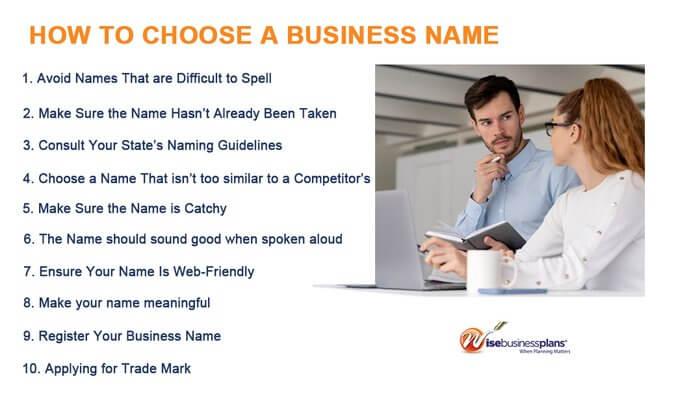How to Choose a Business Name
Table of Contents
- 10 Tips to Choose a Business Name
- 1. Avoid Names That are Difficult to Spell
- 2. Make Sure the Name Hasn’t Already Been Taken
- 3. Consult Your State’s Naming Guidelines
- 4. Choose a Name That isn’t too similar to a Competitor’s
- 5. Make Sure the Name is Catchy
- 6. The Name should sound good when spoken aloud
- 7. Ensure Your Name Is Web-Friendly
- 8. Make your name meaningful
- 9. Register Your Business Name
- 10. Applying for Trade Mark
- FAQs:
Wise Business Plans® is one of the best companies that write business plans.
10 Tips to Choose a Business Name
If you’re not sure of the steps to take in choosing and protecting your business name, here are a few tips to help you get started.
1. Avoid Names That are Difficult to Spell
Many sites limit character counts or restrict name length in other ways, so try not to pick a name that’s too long. Your online business listing should be easy to find so that potential customers can find your business easily. In order to avoid having to continually correct your misspelled name, you need to make sure it is spelled correctly. Keeping it simple is best. Avoid very long names and strange wordings.
Many businesses start out as private projects, solo operations, or partnerships. In these cases, it’s easy to fall back on your own name as your company name. Sometimes this can make it tougher to present a professional image, build brand awareness, and connect your products with your target market’s demand.
2. Make Sure the Name Hasn’t Already Been Taken
Pick a name that hasn’t been claimed by others, online or offline. It should be rich in keywords that reflect what your business does. A quick web search and domain name search will let you know if your desired name is already in use. You can do this using the WHOIS database of domain names.
Also remember, trademark infringement can carry a high cost for your business. Before you pick a name, use the U.S. Patent and Trademark Office’s trademark search tool to see if a similar name is trademarked.
If you have checked and your business name is not in use, be sure to claim it immediately. To get started registering your domain name there are several sites available to choose from.
3. Consult Your State’s Naming Guidelines
In most states, if you form a business entity such as a corporation or limited liability company, you cannot use a name that is already owned by another organization in your state. It is also against the law in some states to use a name that is deceptively similar to another business entity’s name.
The naming guidelines for your state may be found on the website of the state agency that handles business filings. You can search for registered business names online to see if the name you want is available in your state.
4. Choose a Name That isn’t too similar to a Competitor’s
Be aware of your competitors who use names that are similar to the one you want when you’re looking for a unique name. Choose a business name that won’t confuse your business with other businesses of the same type in your area.
5. Make Sure the Name is Catchy
Ideally, you will be able to protect your business name with a trademark. But this can be challenging for small businesses.
The names of generic or geographical companies, such as “Best Plumbers” or “Chicago Pizza”, may be great for attracting customers, but they cannot receive trademark protection. Conversely, the names that are most likely to become trademarks are comprised of words like ‘Xerox’, which can leave a small business’s potential customers scratching their heads.
Recommended: How to trademark a name
6. The Name should sound good when spoken aloud
The names in a book seem great on paper, but sound terrible when said out loud. You should also make sure that if it is said aloud people don’t get confused as to how it is spelled.
7. Ensure Your Name Is Web-Friendly
You probably have a website for your business as well as a Facebook page. There are also other social media platforms you may use for your business. Check if you can get a domain name for your business that matches your business name, as well as social media accounts in your business name.
8. Make your name meaningful
In an ideal world, your business name should convey something positive and meaningful about your business. Is it easy for people to understand what your business is about? Even though meaningless names like “Google,” “Yahoo,” or “Zappos” are catchy and sound, they are more expensive to brand compared to meaningful names.
9. Register Your Business Name
10. Applying for Trade Mark
Checkout our free business plan examples now!
FAQs:
When choosing a business name, consider factors such as brand relevance, uniqueness, memorability, and availability of domain names and trademarks. It’s important to select a name that aligns with your business’s values and target audience.
Conduct a thorough search to ensure that your chosen business name is not already in use by another company. Check online directories, trademark databases, and search engines to verify its availability. It’s recommended to consult with a legal professional for a comprehensive search.
The choice between a descriptive or creative business name depends on your branding strategy. Descriptive names clearly communicate the nature of your business, while creative names allow for more uniqueness and differentiation. Consider your target audience and industry norms when making this decision.
Yes, using your own name as the business name can add a personal touch and authenticity. However, consider if it aligns with your long-term goals and if it adequately represents your business’s products or services.
It’s essential to ensure that your chosen business name doesn’t infringe on trademarks or copyrights of existing companies. Conduct a thorough trademark search and consider consulting with a legal professional to ensure compliance with local regulations and laws.


